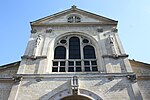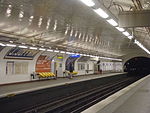Montmartre Synagogue
Buildings and structures in the 18th arrondissement of ParisMontmartreOrthodox synagogues in FranceSephardi Jewish culture in FranceSephardi synagogues ... and 2 more
Synagogues completed in 1939Synagogues in Paris

The Montmartre Synagogue (French: Synagogue de la rue Sainte-Isaure) is situated on the Rue Sainte-Isaure, in the 18th arrondissement of Paris. Since 1904 a small Jewish temple has been functioning at this location. In 1907, baron Edmond de Rothschild contributed to its expansion. During the Second World War, in 1941 the synagogue was damaged by far-right French collaborators. · · .
Excerpt from the Wikipedia article Montmartre Synagogue (License: CC BY-SA 3.0, Authors, Images).Montmartre Synagogue
Rue Sainte-Isaure, Paris Montmartre
Geographical coordinates (GPS) Address Nearby Places Show on map
Geographical coordinates (GPS)
| Latitude | Longitude |
|---|---|
| N 48.893611111111 ° | E 2.3438888888889 ° |
Address
Synagogue de la rue Sainte-Isaure
Rue Sainte-Isaure 13
75018 Paris, Montmartre
Ile-de-France, France
Open on Google Maps









